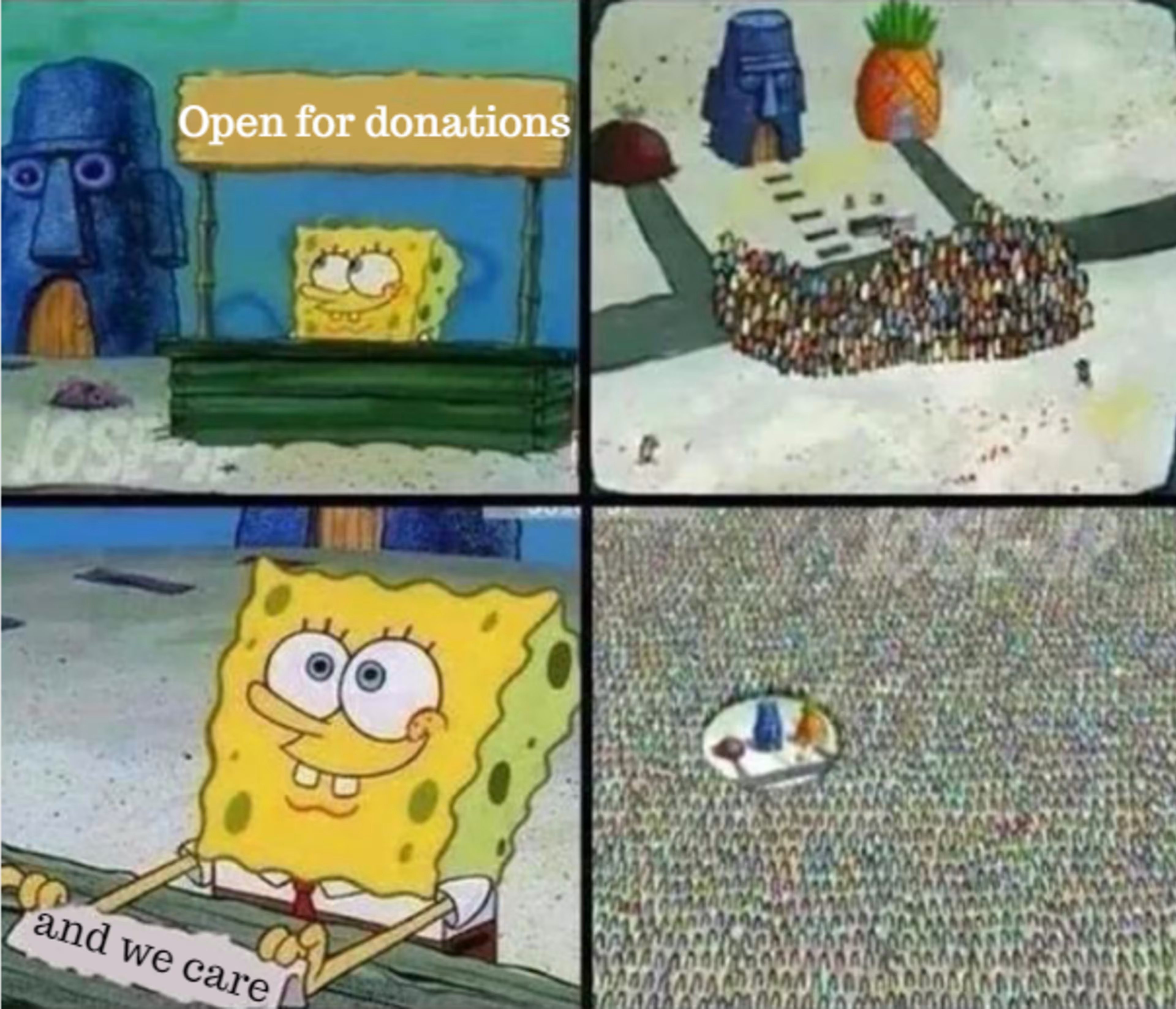Successful relationships require time, patience, and lots of hard work. Romantic relationships always need an effort made on everybody’s part to ensure its success, no matter how comfortable you two have become. Otherwise relationships deteriorate and in the end, neither of you will grow as a couple.

Nonprofit fundraising is the same as any other relationship. The relationship between your organization and your donors is one that is built on a foundation of trust and hard work. If not, what reason would anyone have to give their hard-earned money to you?
Making mistakes in relationships is normal, but there are certain ones that you must take great care to avoid, such as lying or infidelity. Similarly, there are several mistakes that you must avoid if you hope for your nonprofit to succeed (such as neglecting your nonprofit software).
Harmful Fundraising Mistakes
Not every campaign your nonprofit backs will succeed—that’s a reality of the industry. Resources are mislocated on occasion or some projects are too ambitious for the size of your organization. Yet, fundraising is the one aspect you’ll want to avoid as many hiccups in as possible. Fundraising is the life’s blood of your organization and if the benefactors up and leave, it is hard to pick up the pieces.
To prevent this from happening, these are the six harmful fundraising mistakes you want to avoid if you hope to be successful.
1. Lacking donor cultivation

Cultivating your relationships with donors is a lot like dating. If you ask someone out on a date and refuse to show up or show any interest during the date, chances are this relationship isn’t going anywhere.
Cultivation is all about sparking and building those important relationships with your donors. Donors won’t flock to your organization because you exist like dates won’t line up in front of your doorstep because you’re available. You have to go out of your way to attract donors with marketing campaigns, networking events, and presentations.
What’s more, once a donor agrees to give to your organization and cause, it’s important to do all that you can to continue your relationship with them besides ask for money every month.
Here are some tips to make the most of your donor cultivation efforts.
Donor cultivation tips:
Use emotional appeals to win your donors over. While facts and figures are important tools to give context to a concept, emotions are what truly ropes in a person’s interest. For example, despite the fact that The Theory of Everything is the story of a theoretical physicist, the emotional aspects of Stephen Hawking’s condition and his success in the face of adversity are what make his story compelling.
Attracting new large donors requires more than email requests. Schedule phone calls, meetings, and other more personal methods to entice and call upon the help of prospective donors.
Make use of your established relationships with current donors to find new prospects. If a current donor assures their friends of the work your organization if doing, this goes a long way in building a new relationship.
If you follow these tips, your donors will thank you for the care you took when soliciting their help.
2. Bombarding new social media followers with donation requests

Imagine making a new acquaintance at a networking event only to have them ask you for money five minutes into the conversation. I don’t know about you, but I would be shocked that person would make such presumptions that I would give them money after having just met them. It’s rude and it’s off-putting.
If you wouldn’t do that to someone you just met, why would you do it to a new social media follower? Automated social media messaging is a great way to introduce your organization and connect them to your website. But asking for money before this follower has the chance to research your nonprofit is an easy way to turn them off to your organization.
This also sends an indirect message to your followers that your number-one focus has always been and will always be “show me the money.” Instead, link your messages to useful content, such as a blog or recent news coverage about the work your organization is doing.
3. Only asking for money

There was a time when I didn’t have money to give to causes or campaigns that I supported, so instead I gave away my time to volunteer for them. Several of these organizations now receive money from me due to my lack of available time.
Just because some don’t have the money to give doesn’t mean these individuals don’t have value to contribute. Presenting opportunities to volunteer gives you the chance to cultivate workers until they have the money to give.
Millennials in particular have a great desire to give to causes they care about, but unlike previous generations, they lack the financial resources to do so.
Ways to attract and maintain volunteers:
Make your volunteers feel important by assigning titles and responsibilities; utilize volunteer strengths and weaknesses.
Give your volunteers a sense of belonging by remembering their names, invite them to team building activities, and ask for their input on volunteering activities.
Record the contact information of all volunteers
Provide perks and rewards to your volunteers, such as gift cards, sporting event tickets, and free lunches.
Host volunteer recognition events.
Volunteering ideas:
Event staffing
College campus activism
Phone banking
Item drives (food, clothing, etc.)
Writing off these givers because they don’t have the money to give, especially Millennials, risks shutting the door on tons of future contributions.
4. Not suggesting donation amounts

Remember when you were a teenager and you needed money from your parents to go to the movies with your friends? You would never ask your parents for a “blank check” when asking for money because either they would give you too little or more than you would need. Chances are if your parents were like mine, the amount would err on the side of “too little” if you weren’t specific.
It is best to be specific about the amounts you will need to continue operations when asking for donations. But what is the right amount to suggest?
According to the Wall Street Journal, a study by Professor Oleg Urminsky of the University of Buffalo sought to answer this question:
What they discovered is that there is no one-size-fits-all approach for nonprofits—’no happy middle ground’ between setting relatively high suggested donations and setting them lower that captures the benefits of both approaches, says Dr. Urminsky.
Where it gets tricky is that not everyone donates. In many fundraising situations, actually fairly few people donate. And setting a higher suggested amount could actually discourage people—people who might have participated if a lower amount had been suggested—from donating at all.
Setting a low default increases participation because it validates or gives permission to make a small contribution. We call this a ‘warm glow at a discount.’ The problem here is people who could have given more, give less.
While Professor Urminsky’s study was unsuccessful in finding a concrete dollar amount, he goes on to suggest that optimal “ask” depends on the population.
To avoid this fundraising mistake, my advice is to start low for requests and gradually increase your request amounts until you see a downturn in fundraising results. Even then, populations may change due to a multitude of factors including economic downturns and demographic changes.
The important thing is that it is better to suggest a donation amount rather than “leave the check blank.”
5. Bragging about your low overhead
Every relationship has to start off with the right expectations, whether it’s a dating relationship or a donor relationship. When dating, you shouldn’t set unrealistic expectations about your cooking abilities or how clean your apartment is. Nonprofits, on the other hand, shouldn’t make the classic fundraising mistake of setting unrealistic expectations about their spending, especially pertaining to overhead.
It is commonplace for nonprofits to brag about their low overhead. Donors and organizations alike embrace this idea that a low overhead is something to strive for, when in reality these practices are starving otherwise effective organizations of essential infrastructure funding.
Amy Eisenstein, a professional fundraising consultant, detests the corner many nonprofits have painted themselves into:
“Sadly, the overhead myth is not only perpetuated by the media and donors, but by nonprofit professionals and board members too.
I’ve been at more than one board meeting where board members and staff members take pride in their low overhead costs. Not to mention nonprofit leaders bragging about zero percent of donor contributions going to fundraising costs. What a fabrication!
As leaders in the nonprofit sector, we need to realize that high fundraising costs are often an investment in future fundraising, and therefore impacts the ability of the organization to expand and grow. By not investing in fundraising, nonprofit leaders are deciding to stunt growth potential of the organization.”
Eisenstein goes on to explain the difference between prioritizing impact vs. overhead. She argues that she would rather give money to an organization that spends 45% on overhead but has the capabilities to regularly evaluate its programs, rather than one that spends 10% on overhead but cannot evaluate its impact.
I’m inclined to agree with Eisenstein. Even if you divert as much of your funding as possible towards programs, there is no guarantee that those programs are successful if you do not have the infrastructure provided by overhead spending to evaluate their effectiveness.
There are other metrics to use to make your case for new and existing donors, such as campaign results, members acquired, aid provided, etc.
Bragging about low overhead costs sets unrealistic expectations about what your nonprofit is capable of and is a fundamental fundraising mistake. Stop using overhead costs as a fundraising tool.
6. Neglecting donor retention

Fundraising is a constant battle between finding new donors and keeping the existing ones around long enough to make an impact. The truth is, it’s expensive to seek out new contributors, from marketing costs to donor drive events. It is far easier and more cost effective to keep donors happy rather than seeking out new prospects every time old ones drop off.
Neglecting donor retention is a huge mistake that is potentially costing your nonprofit thousands of donors and no leaking ship stays afloat indefinitely. Luckily there are plenty of donor retention strategies out there to keep your beneficiaries happy and engaged with your nonprofit.
Donor retention strategies:
Send out thank you emails, let them know about the progress of your cause, or send out a newsletter commending donors for their charitable giving. The more a donor does for you, the more communication and relationship fostering is required.
Transparency with your donors is a must. The donations given to your organization (hopefully) aren’t thrown into a black hole, so it is important to let your donors know what you will be doing with their hard earned money.
Involve your donors in projects to give them a firsthand account of the changes their donations are bringing. Invite them out on building projects, invite them to speak at your events, or bring them along to witness disaster areas that you are engaged in.
Create tiered reward systems for donors, such as reduced or free admissions to events, free food/drink vouchers for events, t-shirts or other gear, or entries into monthly drawings for prizes.
Name your projects after large scale donors (or build a memento with all of the contributors to a specific project)
Of course not all donors will stick around indefinitely, but if you are doing all that you can to stem the outflow, your fundraising will reflect your efforts.
More fundraising mistakes and solid fundraising resources?
Now that you know what not to do when fundraising, it’s time you dive into other resources on how to improve your fundraising campaigns with new tips, software systems, and gadgets.
Be sure to check out this other Capterra blog post and take your fundraising game to the next level: